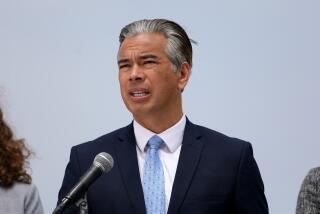Fines Proposed in Alaska Ballast-Dumping Case : Environment: A total $20,000 is levied against Exxon, British Petroleum and Alyeska Pipeline, which are accused of waste-water violations.
- Share via
The Environmental Protection Agency on Wednesday proposed fining Exxon Corp., British Petroleum and Alyeska Pipeline Service a total of $20,000 for two incidents last spring in which oil tankers allegedly violated an EPA permit by discharging dirty ballast into a treatment plant at the Alyeska terminal in Valdez, Alaska.
The EPA said the two tankers involved, the Tonsina, leased to BP, and the Exxon New Orleans, unloaded oily ballast containing so-called tank washings that had been transferred to the tankers from other vessels.
The discharges contained “significant amounts of oil” in violation of special permission that the EPA had given the tanker operators, EPA’s Greg Kellogg said Wednesday. Kellogg, chief of the water compliance section at the agency’s regional office in Seattle, said the proposed fine of $10,000 per violation is the maximum allowable under an administrative complaint such as Wednesday’s.
Alyeska and the oil companies deny the allegations and plan to meet with EPA officials to try to reverse the recommendation.
“It’s strictly a procedural management issue, and we have differences between professionals--well-meaning professionals,” said George P. Wuerch, vice president for corporate affairs at Alyeska in Anchorage.
Wednesday’s action is the first result of an investigation opened last February by the EPA and the Alaska Department of Environmental Conservation.
“It’s a first step, and I’m really glad the EPA had the nerve to do it, but I hope it doesn’t stop here,” said Riki Ott of Cordova, Alaska, president of the Oil Reform Alliance, an environmental coalition.
The probe began after former oil tanker broker Charles Hamel accused Exxon of accepting hazardous liquid wastes from barges or tankers in California, shipping them to Alaska in the ballast water of oil tankers and then running the liquid through the Alyeska treatment plant. But, because the plant is designed only to separate oil from water, much of the waste was dumped untreated into Valdez Harbor, Hamel charged.
Hamel of Alexandria, Va., is an industrial gadfly now suing Exxon in a business dispute. In a telephone conversation Wednesday, he called the EPA’s enforcement efforts “sheer comedy,” adding that Exxon and BP must be “quite pleased” with the size of the proposed fine. “This is a lot cheaper than doing the right thing,” Hamel said.
After Hamel had made his charges in a February letter to EPA Administrator William K. Reilly and U.S. Atty. Gen. Richard L. Thornburgh, state and federal agencies tightened their oversight of the disposal of ballast in Alaska’s coastal waters. The EPA started requiring advance authorization before ballast could be unloaded at the Valdez plant.
The Tonsina and the Exxon New Orleans each received such authorization, but “subject to the condition that only the water layer of the ballast” be discharged into the plant, according to an EPA statement Wednesday.
Tankers headed for Alaska take on seawater as stabilizing ballast. As they steam north, the ballast settles into layers, with residual crude oil and sometimes other toxic components at the bottom.
To minimize pollutants that enter the plant, the EPA asks tankers to make a “conservative cut” of the ballast, discharging only the upper, watery portion.
Alyeska’s Wuerch said the oil firms believe that they complied with the EPA’s conditions.
More to Read
Sign up for Essential California
The most important California stories and recommendations in your inbox every morning.
You may occasionally receive promotional content from the Los Angeles Times.










